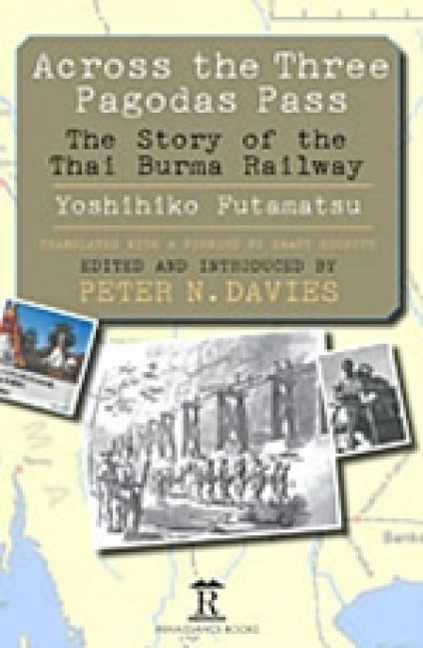Book contents
- Frontmatter
- Dedication
- Contents
- Acknowledgements
- Foreword
- Introduction
- Across the Three Pagodas Pass
- Translator’s Acknowledgements
- Preface
- Chapter 1 Departure for the Front
- Chapter 2 In Indo-China
- Chapter 3 Opening of Hostilities
- Chapter 4 The River Krian
- Chapter 5 The Malayan Campaign
- Chapter 6 The Fall of Singapore
- Chapter 7 Surrender
- Chapter 8 Shōnan: Light of the South
- Chapter 9 The Thai-Burma Railway
- Chapter 10 Preparing Construction
- Chapter 11 Banpong
- Chapter 12 Prisoners-of-War
- Chapter 13 Constructing the Railway
- Chapter 14 Thailand
- Chapter 15 The River Kwae Noi
- Chapter 16 The Mae Khlaung Bridge
- Chapter 17 Kanchanaburi
- Chapter 18 The Jungle
- Chapter 19 From Bangkok to Singapore
- Chapter 20 Rush Construction
- Chapter 21 The Base at Wanyai
- Chapter 22 The Labour Force
- Chapter 23 Survey Unit
- Chapter 24 Test Run
- Chapter 25 Bridge-Building and Shifting Earth
- Chapter 26 The Rainy Season: The Monsoon
- Chapter 27 Kinsaiyok
- Chapter 28 Diseases and Epidemics
- Chapter 29 Cattle Drive
- Chapter 30 Living in the Jungle
- Chapter 31 Soon to the Three Pagodas Pass
- Chapter 32 Towards the Setting Sun
- Chapter 33 Opening to Traffic
- Chapter 34 The Bombing
- Chapter 35 End of the War
- Chapter 36 Internment
- Chapter 37 Repatriation
- Footnote
- Postscript
- End Notes
- Glossary
- Bibliography
- Index
Introduction
Published online by Cambridge University Press: 13 May 2022
- Frontmatter
- Dedication
- Contents
- Acknowledgements
- Foreword
- Introduction
- Across the Three Pagodas Pass
- Translator’s Acknowledgements
- Preface
- Chapter 1 Departure for the Front
- Chapter 2 In Indo-China
- Chapter 3 Opening of Hostilities
- Chapter 4 The River Krian
- Chapter 5 The Malayan Campaign
- Chapter 6 The Fall of Singapore
- Chapter 7 Surrender
- Chapter 8 Shōnan: Light of the South
- Chapter 9 The Thai-Burma Railway
- Chapter 10 Preparing Construction
- Chapter 11 Banpong
- Chapter 12 Prisoners-of-War
- Chapter 13 Constructing the Railway
- Chapter 14 Thailand
- Chapter 15 The River Kwae Noi
- Chapter 16 The Mae Khlaung Bridge
- Chapter 17 Kanchanaburi
- Chapter 18 The Jungle
- Chapter 19 From Bangkok to Singapore
- Chapter 20 Rush Construction
- Chapter 21 The Base at Wanyai
- Chapter 22 The Labour Force
- Chapter 23 Survey Unit
- Chapter 24 Test Run
- Chapter 25 Bridge-Building and Shifting Earth
- Chapter 26 The Rainy Season: The Monsoon
- Chapter 27 Kinsaiyok
- Chapter 28 Diseases and Epidemics
- Chapter 29 Cattle Drive
- Chapter 30 Living in the Jungle
- Chapter 31 Soon to the Three Pagodas Pass
- Chapter 32 Towards the Setting Sun
- Chapter 33 Opening to Traffic
- Chapter 34 The Bombing
- Chapter 35 End of the War
- Chapter 36 Internment
- Chapter 37 Repatriation
- Footnote
- Postscript
- End Notes
- Glossary
- Bibliography
- Index
Summary
A horror story of brutality, inefficiency and inhumanity may be described by a writer from a totally different culture in terms which we in a Christian society must find inadequate. It is fascinating to uncover, so far as we can, the reasons lurking behind such apparent inhumanity and to describe the actual situation in which these things took place.
Futamatsu himself was a dedicated professional railway engineer and also, like his CO, fair-minded, always ready to see both sides of an argument. During the Pacific War he was not greatly affected by the militaristic propaganda with which the Army flooded the nation in ‘the dark valley’ of the 1930s. His commander had read engineering at Tokyo Imperial University, but of course, as a regular soldier, he had to comply with superior orders which in theory emanated from an Emperor who was still divine. I suspect that Futamatsu heroworshipped his Colonel, and the Colonel certainly recognized his subordinate's professional skill. Their association ripened into warm friendship.
The Thai-Burma Railway was a necessary concomitant in the Japanese Army's assault through Burma into India, one which came to the fore as a result of the US Navy's successful action off Midway Island in the Pacific in 1942 when most of Japan's aircraft-carriers were sunk or damaged. The British Far East Naval Squadron took control of the Indian Ocean, in particular of the Andaman Sea off the coasts of Malaya and Burma, so it became vitally necessary for the Japanese Army to develop an overland trucking route across the Three Pagodas Pass and on to Moulmein in Burma, to facilitate their invasion of India.
Looking ahead to the possibility of some such eventuality, Imperial Japanese Army General Headquarters in Tokyo had taken on a civilian railway engineering expert in 1939. Using Thai maps, Kuwabara proposed the building of a railway to connect Thailand with Burma. He calculated that it would take two years to complete. Officially ‘The Railway to link Thailand with Burma’, it became known as the Thai-Burma Railway.
- Type
- Chapter
- Information
- Across the Three Pagodas PassThe Story of the Thai-Burma Railway, pp. xxvii - lviiiPublisher: Amsterdam University PressPrint publication year: 2013



